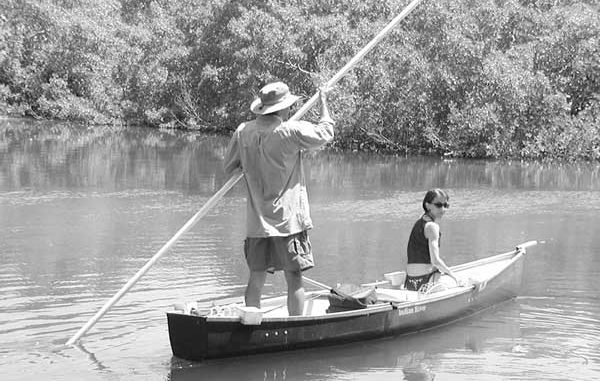
Nature has taken many years to delicately handcraft the perfect Sportsman’s Paradise.
Television executives aren’t satisfied that they’ve turned us all into couch potatoes; now they’re trying to turn our felines into “fat cats.”
Last month, I witnessed the first episode of Meow TV, the first show targeted for cats. That’s right — kitty does the watching. There were bouncing balls, squirrels, birds and pieces of string being pulled across a floor. I must confess — it was more entertaining than most of the network shows I’ve been watching lately.
If successful, the results could be cat-astrophic. I already have to fight the kids for the remote control. Will I have to fight my pets off too?
At least some humans are on the road to recovery from “couch slouch.”
Anglers who fly fish from canoes and kayaks — we call ourselves puddlers — can claim to burn those accumulated calories while in pursuit of piscatorial pleasure. As example, after paddling miles each day during a week of vacation, I came back 6 pounds lighter. If I can keep this up for the rest of the year, by Christmas I should weigh about 40 pounds.
Which canoe or kayak is best for you? Perhaps none, but if there is one, it’s based on what YOU think is most important. Ask 30 different puddlers what they recommend, and you might get 30 different answers.
You must realize that everything about paddlecraft is a trade-off: longer (faster, harder to handle) versus shorter (easy to handle, less weight, harder to track), wide (stable, slower) versus narrow (faster, less stable), canoe (carrying capacity, slower, less wind-resistant) versus kayak (faster, more wind-resistant, sit-down stability, no stand-up stability, little capacity), fiberglass (light but vunerable) versus polyethylene (heavy but tough). And I could go on and on.
Puddling has been going strong for several years, and based on experiences of the masses, the market seems to have settled out. A few years ago, sit-on-top (SOT) kayaks were all the rage. Recently there’s been a definite trend back to cockpit kayaks and solo canoes. But I think the real trend is toward particular characteristics, as opposed to the type of craft.
For example, the most popular yaks are usually 11-14 feet long, 29-31 inches wide, and weigh under 50 pounds. Cockpit yaks with large openings, like the Old Town Loon 111, Wilderness Systems Pungo 120 and Perception Sundance 120 meet the need for accessible storage while providing top speed and low wind-resistance.
For canoes, Royalex types like Old Town Pack 120 and Mohawk Solo 13 combine light weight and easy handling with comfort and accessibility.
Don’t be fooled by claims that you can stand up in a yak. Only canoes can honor that promise, and just a few at that and only under the right conditions. My OTC Guide 147 is ideal for push-poling in the marsh, or standing up (one person only) while fishing.
Many of the OTC and Mohawk canoes do well with a trolling motor, if that’s your bag. But again, there’s a tradeoff: These tandem canoes often weigh over 70 pounds, and it’s in large part this weight that gives them their extraordinary stability.
I find a lot of magazine articles on selecting a paddlecraft for fishing duplicate what you read in the manufacturer’s catalogs. To get the real scoop, you need to check out related web sites with forums, e.g. paddling.net, paddle-fishing.com, laflyfish.com and kayakfishing.com.
It was from these web sites that I was able to customize my Guide 147 into one heck of a fishing machine. She now has dual-end anchoring systems and a trolling motor bracket, all custom-made, and a stand for my push pole.
The trolling motor is reserved for those 90/90 days — 90 degree heat and 90 percent humidity. From the forums, I learned a safer alternative to the conventional marine battery was a fiberglass mat battery, a.k.a. AGM battery. This sealed battery can survive punctures, turnovers, vibration and even submersion. And with a size U-1 AGM battery — weighing only 22 pounds — I can cover 3 miles at 3/4 speed, using a Minn-Kota 30-pound-thrust motor drawing 30 amps, with no appreciable loss in power.
Most of the time I paddle. Thanks to the forums, several of us canoeists switched to two-piece double-bladed kayak paddles, length 240 to 260 centimeters. When paddling from point A to point B, the yak paddle gives improved speed and efficiency. When working an area, the standard canoe paddle works better. By using a T-adapter, you can make the transition from double-bladed to single blade in seconds.
A Legend Leaves Us
Tom Nixon, the subject of our March column, passed away recently from cancer.
One of the most respected warmwater fly anglers in America, Nixon resided in Lake Charles, and was the author of Fly Tying and Fly Fishing for Bass and Panfish as well as the creator of many great flies, such as the Calcasieu Pig Boat and the 56er.
He actively gave of his time and resources to clubs and Federation of Fly Fishers events. Nixon had a sharp wit and many great anecdotes. He will be sorely missed by all of us.


